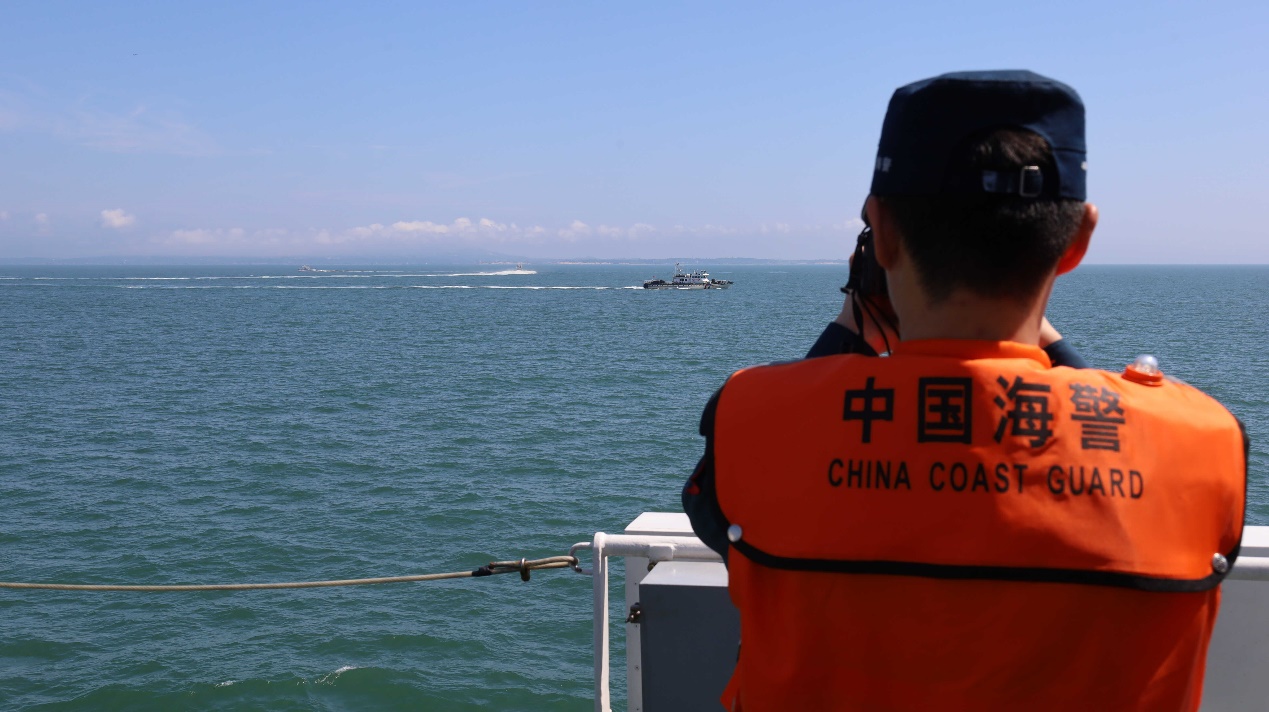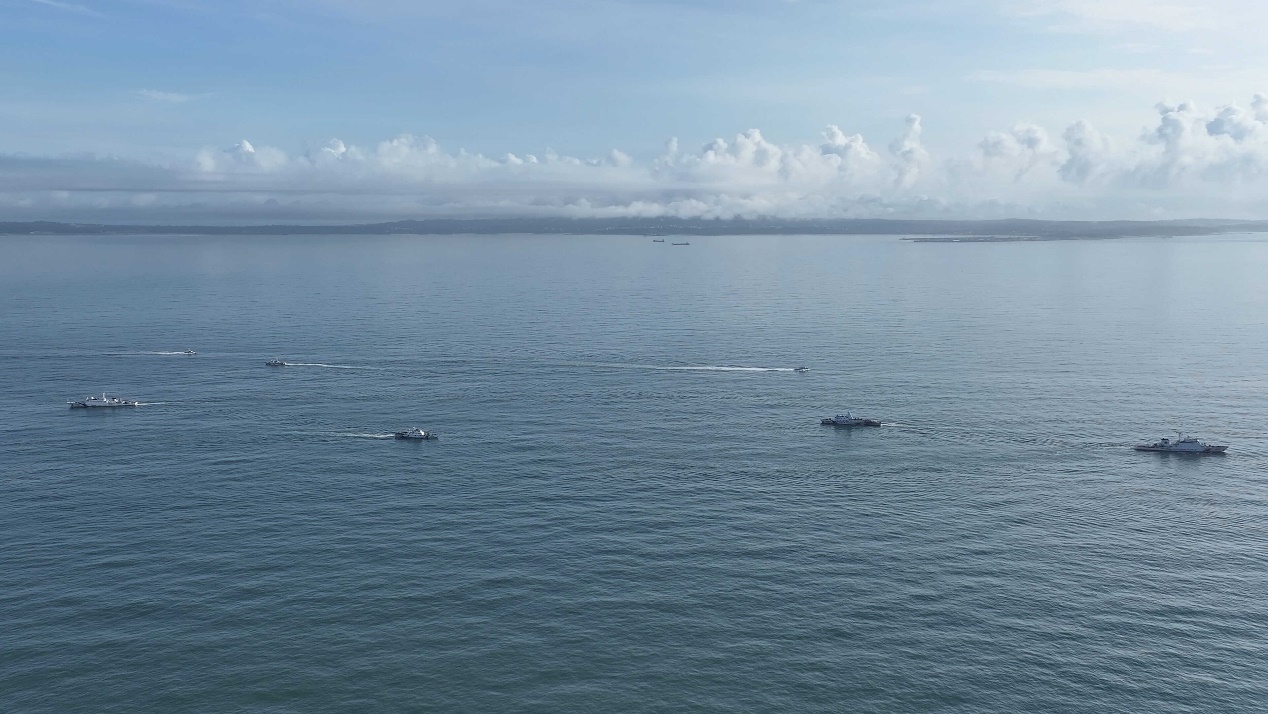
The Fujian Coast Guard carried out regular law enforcement patrols in the waters near Kinmen on June 25, 2024. Photo: website of China Coast Guard
The Fujian Coast Guard carried out regular law enforcement patrols in the waters near Kinmen on Tuesday. Experts said on Wednesday that the mainland’s coast guard adopted a new model of conducting law enforcement by expanding the scope of enforcement, which has seen a transition to “all-weather enforcement” and further enhanced the intensity.
Some experts said the maritime enforcement model near Kinmen can serve as a successful example for promoting the One Country, Two Systems, providing an optional solution for ultimately resolving the Taiwan question and achieving cross-Straits reunification.
Since June, the Fujian Coast Guard has organized a fleet of warships to continuously strengthen law enforcement patrols in the waters near Kinmen, and earnestly safeguard the legitimate rights and interests of Chinese fishermen, including those in the island of Taiwan.
According to observations from the Automatic Identification System (AIS) and other open-source information, previous law enforcement patrols by the China Coast Guard (CCG) were carried out along fixed routes and with fixed formations. This time, however, after completing patrols along a fixed route, the CCG adopted a new model, conducting law enforcement activities in single ships or pairs, Yuyuan Tantian, a social media influencer affiliated with state broadcaster CCTV, said in a post on Weibo on Wednesday.
Since the first law enforcement patrol near Xiamen and Kinmen waters on February 18 this year, the CCG has been enforcing the law near Kinmen for over four months.
During this period, to adapt to the changing enforcement situation in the Kinmen waters, the CCG has been making targeted adjustments to its actions, the social media influencer said.
Reviewing the four-month enforcement journey of the CCG, it is evident that the enforcement scope has progressed from "points to lines to areas."
In the first two months, the CCG chose an enforcement method that delineated several points within the "prohibited and restricted waters" defined by the DPP authorities and dispatched a coast guard vessel formation to patrol along these points.
In other words, initially, the purpose of the CCG's patrols was to debunk the DPP authorities' narrative and demonstrate that there are no so-called "prohibited or restricted waters" near Kinmen.
From April to May, the frequency of the CCG's patrols near Kinmen increased, with multiple enforcement routes covering various waters south and east of Kinmen islands.
This time, with the new model, the enforcement scope has expanded from lines to areas—since the routes are not fixed, the patrol tracks of the coast guard vessels now form extensive patrol zones. This indicates that our control over the waters near Kinmen has been further strengthened.
The uncertainty of patrol routes means that the timing of the CCG's appearance in any given area is also unpredictable – coast guard vessels can appear in any part of the Kinmen waters at any time.
Some experts said the freedom in route and timing allows the CCG to ensure continuous enforcement and ability to respond appropriately at any time and place. In other words, for those who wish to stir up trouble in the Kinmen waters, there is no opportunity to exploit any gaps.
Chen Xiangmiao, director of the World Navy Research Center at the National Institute for South China Sea Studies, said that Kinmen Island is located nearshore, with relatively easy-to-grasp climate and hydrological conditions, enabling the CCG to carry out all-weather enforcement patrols.
Some media reported that the coast guard began their enforcement actions this time as early as 5 am.
The mainland has been continuously monitoring meteorological and hydrological data for the waters near Kinmen and the Taiwan Straits, providing support for the coast guard's enforcement patrols, Yuyuan Tantian learned.
Conducting enforcement actions with a formation of coast guard vessels showcases a stance of "specialized enforcement rights protection actions" near Kinmen waters, Chen said.
The new model marks a shift toward routine and daily enforcement, indicating that the CCG has firmly established actual control and enforcement rights over the waters near Kinmen. This means that the island’s “coast guard” no longer dares to act rashly near Kinmen waters.
Liu Kuangyu, an expert on the Taiwan question, was quoted as saying in the post that Xiamen and Kinmen have always had close exchanges.
Legally and practically, in terms of enforcement rights and actual control over the relevant waters, Xiamen and Kinmen have achieved deep integration, with only a final step remaining for complete reunification.
The maritime enforcement model near Kinmen can serve as a successful example for promoting the One Country, Two Systems, providing an optional solution for ultimately resolving the Taiwan question and achieving cross-Straits reunification, the expert said.
However, certain forces are attempting to disrupt this process. For example, the US Department of Defense recently announced a $360 million arms sale plan to Taiwan, including drones. Some experts said Kinmen has always been the frontline of resistance by the DPP authorities against the mainland. It is almost certain that some of these drones purchased from the US will be deployed on Kinmen Island.

The Fujian Coast Guard carried out regular law enforcement patrols in the waters near Kinmen on June 25, 2024. Photo: website of China Coast Guard
Almost simultaneously, Chinese authorities issued a set of guidelines on imposing criminal punishments on diehard "Taiwan independence" separatists for conducting or inciting secession, which allow the death penalty and a trial in absentia in relevant cases and stipulate that those who are found to have colluded with any foreign or overseas institution, organization or individual in committing such crimes should be handed a harsher punishment.
The guidelines apply to the waters near Kinmen as well as the entire Taiwan Straits and the island.
Experts noted that the actions undoubtedly strike at the attempts of "seeking independence with foreign support" and "seeking independence with military force." This means that the DPP authorities' space to create disturbances in the Kinmen waters and other matters is continuously being compressed. The final step to complete reunification is approaching.



